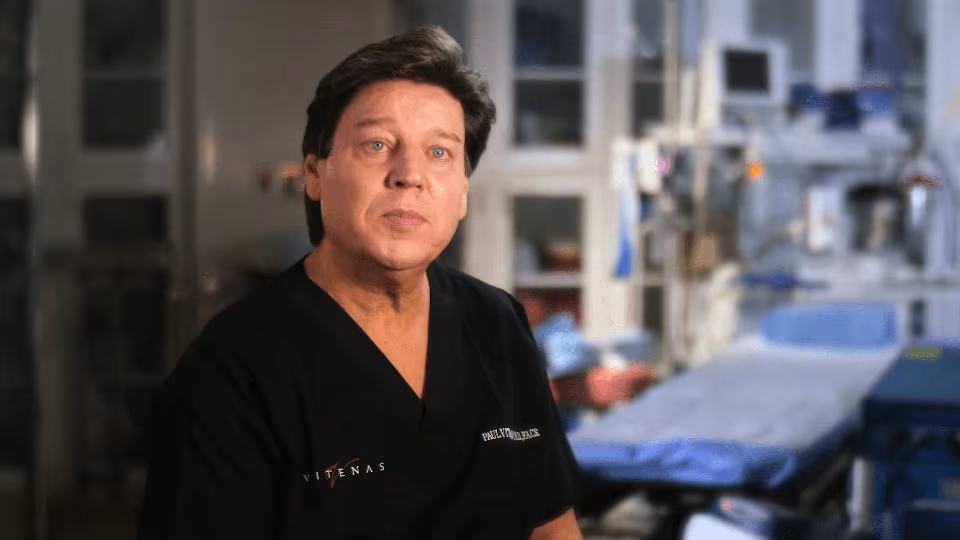30+ Years of Experience
3k+ Real Patient Reviews
10,000+ Breast Surgeries Performed
Texas Super Doctor
Breast Implant Exchange in Houston
If you have problems with your breast implants or would like to exchange your implants, Dr. Vitenas is an expert with over 30 years of experience performing breast impant exchanges and repairs.

Discover why patients from across the U.S. and around the world choose Dr. Vitenas as the premier surgeon for naturally-appearing breasts.
Breast Implant Exchange Before & After Photos





Each Patient is Unique and Individual Results May Vary
Experience the Comforting Benefits of Implant Exchange
Uncover the allure of self-confidence and satisfaction with the Breast Implant Exchange. This groundbreaking procedure, catered to your personal aspirations, strives to enhance the outcomes of a previous augmentation and alleviate any discomfort, leaving you feeling refreshed and rejuvenated.
IMPROVED AESTHETICS
Tailor your appearance with the Breast Implant Exchange. Say yes to a more balanced and natural look, aligning with your personal style and comfort.
PAIN ALLEVIATION
Let’s bid farewell to painful scar tissue. The Implant Exchange ensures you a smoother and pain-free journey towards your ideal physique.
PERSONALIZED ADJUSTMENTS
Embrace the freedom to revise your choice. The Implant Exchange procedure offers the flexibility to tweak implant size or type, driving you closer to your desired results.
About Breast Implant Exchange Surgery
Breast augmentation is an extremely popular cosmetic procedure performed over 300,000 times a year across the United States. While most patients are thrilled with their breast enhancement results, some women find that their breasts are larger or smaller than desired. Others may be bothered by rippling, asymmetry, or other issues with their implants. Breast implant exchange offers a solution to revise and refine the results of initial breast augmentation surgery when implants need to be replaced.

Board-certified plastic surgeon Dr. Paul Vitenas provides breast implant exchange in Houston to help women obtain the beautiful, proportional breasts they want. With decades of experience performing thousands of plastic surgery procedures, Dr. Vitenas has the skill and artistry to exchange current implants for new ones that better match your aesthetic goals.
Breast Implant Exchange with Dr. Paul Vitenas

Dr. Vitenas takes a highly customized, patient-centered approach to breast implant exchange:
- A thorough initial consultation is conducted to understand your concerns with your current implants and learn about your desired outcome. Measurements are taken, and implant size is determined to meet your goals.
- The implant exchange procedure is performed under general anesthesia at Dr. Vitenas' accredited surgery center. Old implants are removed and replaced with carefully selected new saline or silicone implants through small incisions.
- Dr. Vitenas employs advanced techniques to minimize scarring and allow for a smooth, properly positioned implant. The implant size, type, and placement can be adjusted.
The Ideal Implant Exchange Candidate
Breast implant exchange is ideal for women who have undergone breast augmentation in the past and desire some form of correction for their current implants. Possible reasons include size adjustment, correction of rippling or asymmetry, switching of saline and silicone types, or replacement of aged implants.
Good candidates for implant exchange should be in overall good health and hold realistic expectations about the scope of improvement possible.
Before scheduling breast implant exchange surgery, a consultation visit with Dr. Vitenas is required. This appointment will allow Dr. Vitenas to fully evaluate your needs and candidacy, take measurements, and help you select optimal implant specifications to fulfill your goals.

When to Consider Implant Exchange
- Breast size dissatisfaction – Some women find their initial implants make their breasts too small or too large and wish to adjust the size up or down. Weight gain or loss after the original procedure can also prompt a size change.
- Improve breast shape/proportion – Implant exchange may be performed to alter implant dimensions or position to improve aesthetic shape and breast symmetry.
- Switch saline for silicone implants – Today’s silicone implants have a more natural look and feel and are made to last a lifetime. Patients seeking enhanced natural and long-term results may opt to exchange their saline implants for silicone implants.
- Capsular contracture – An implant exchange is often necessary when tight scar tissue around an implant causes pain, distortion, and hardness.
- Deflated saline implants – While uncommon, saline implants can deflate due to a valve leak or tear in the implant shell. Deflated saline implants should be replaced.
- Breast ptosis – Some women develop sagging or “bottoming out” of their augmented breasts over time. A breast lift accompanying implant exchange can rejuvenate breast position and shape.
Recovering After Breast Implant Exchange
The recovery period after breast implant exchange surgery is generally brief, with minimal discomfort. Most patients are able to resume normal daily activities a few days after the procedure.
Prescription medicine helps manage any mild post-op pain or soreness. Your breasts may feel tight and swollen initially as healing occurs. Swelling and bruising typically subside quicker than the initial breast augmentation procedure.
Dr. Vitenas will place all incision sutures internally using absorbable stitches. No suture removal is necessary. He may recommend wearing a supportive sports bra as you heal or suggest wearing no bra. Avoid any strenuous activity or exercise for 6 weeks post-op.
Be diligent about follow-up appointments so Dr. Vitenas can monitor your progress. Complete results become apparent over three to six months as residual swelling dissipates.
The Myth of a 10-Year Breast Implant Shelf Life
There are a few factors that influence breast implant longevity:
- Implant type - Over the years, implant manufacturing has tremendously improved the quality of the implants we have today. Silicone gel implants tend to have greater durability and implant rupture resistance than saline. The cohesive gel in modern implants lends stability as well as longevity.
- Surgical technique - Precise, gentle handling of implants during surgery helps maintain implant integrity. Following all post-op care instructions also prevents premature failure.
- Regular monitoring - Getting periodic exams to check implant condition allows early detection of any issues.
- Individual health/lifestyle - Major weight fluctuations, intense physical activity, and other health issues may contribute to implant wear. A stable, healthy lifestyle helps implants last.
Breast Implant Exchange FAQ
What is breast implant exchange surgery?
Breast implant exchange is a surgical procedure designed to replace existing breast implants with new ones. It may be done for aesthetic purposes or to address medical issues with the current implants.
What are some reasons to consider breast implant exchange?
- Dissatisfaction with current implant size, shape, feel, or position for the implants
- Aging, rupture or deflation of old saline/silicone implants
- Development of capsular contracture or asymmetry
- Desire to switch from saline to silicone implants
- New advances in implant technology and options
Who is the ideal candidate for a breast implant exchange?
Good candidates are women currently with breast implants who are generally healthy and have realistic goals for implant exchange. It is best to wait until after pregnancy and breastfeeding are finished before exchanging breast implants.
Where are the incisions placed for a breast implant exchange?
Incisions are typically placed under the breast in the breast crease fold, allowing for discreet scarring. Dr. Vitenas will determine the optimal incision placement based on factors like implant size and surgical goals.
How is the breast implant exchange procedure performed?
Breast implant exchange surgery is performed as an outpatient procedure under general anesthesia. Dr. Vitenas will make incisions to access the implants, remove the old implants/capsules, irrigate the pockets, insert new implants, and suture the incisions closed in layers.
What is the recovery time for breast implant exchange?
Breast implant exchange recovery time is usually quick, with most patients resuming normal activities within 3-5 days. There may be some initial discomfort managed with medication. Swelling and bruising typically subside within a couple of weeks. Breast shape continues improving over 3-6 months.
When can I return to work after breast implant exchange surgery?
Most patients feel ready to return to work within just 2-3 days following their implant exchange procedure. Desk work duties are possible immediately, while physical jobs may require more time off.
What are the risks or potential complications from implant exchange?
As with any surgery, there are pros and cons of breast implant exchange. Risks may include bleeding, infection, capsular contracture, implant malposition/leak, loss of nipple sensation, asymmetry, and unfavorable scarring. Dr. Vitenas takes precautions to minimize risks during and after the surgical procedure.
Where does Dr. Vitenas perform breast implant exchange procedures?
Dr. Vitenas performs breast implant exchange surgery at his accredited Houston Surgery Center located within the Vitenas Cosmetic Surgery building. This allows a private, comfortable experience in a totally controlled environment.
What is the price for breast implant exchange?
What to expect after breast implant exchange surgery?
After your breast implant exchange procedure, you can expect some mild discomfort that will be managed with prescribed medication, as well as swelling, bruising, and tightness in the breast area as your body heals. There may be temporary changes in nipple sensitivity. You'll notice improvement within a couple of weeks as major swelling goes down. Contact the doctor right away if you have any concerning symptoms like severe pain, bleeding, fever, or redness. Overall you can look forward to enjoying your revitalized, youthful breast contour after this transformative procedure.
What can I expect during the recovery period after breast implant exchange?
During the recovery period, patients may experience some discomfort, swelling, and bruising around the chest area. It's common to be prescribed pain medication to manage any discomfort after the surgery.
How long do breast implants typically last before needing to be exchanged?
Breast implants are not considered lifetime devices and may need to be replaced at some point in the future. Some implants can last many years, between 15 and 20 years or more with proper care, while others may need to be replaced sooner due to complications or changes in the patient's preferences.
What types of breast implants can be used for exchange?
Various types of breast implants are available, including saline, silicone, and structured implants. Dr. Vitenas will discuss the options with you and help you choose the most suitable type for your individual needs and goals.
Can breast implant exchange be combined with other cosmetic procedures?
Yes, breast implant exchange can often be combined with other cosmetic procedures such as breast lift, liposuction, or facial rejuvenation treatments. Combining procedures can help achieve more comprehensive results within a single recovery period.
Will I need someone to drive me home after breast implant exchange surgery?
Yes, it's essential to arrange for someone to drive you home and be with you after surgery as it is required. The effects of anesthesia can cause significant drowsiness and discomfort, making it unsafe to operate a vehicle and one should not sign any legal papers for twenty four hours following general anesthesia.
How soon can I expect to see the final results of my breast implant exchange?
While initial results will be visible shortly after surgery, complete results become apparent over three to six months as residual swelling dissipates. Patience is key during the healing process.
Are there any restrictions on physical activities after breast implant exchange?
Initially, patients are advised to avoid heavy lifting, strenuous exercise, and activities that strain the chest muscles for six weeks. Dr. Vitenas will provide specific guidelines based on your individual case.
What are some signs that indicate a need for breast implant exchange?
Signs that may indicate a need for breast implant exchange include changes in implant position, shape, or size, pain or discomfort, visible rippling or wrinkling of the implants, or any other unusual symptoms.
Can I breastfeed after undergoing breast implant exchange?
Many women are able to breastfeed successfully after breast implant exchange, but it's important to discuss your plans for breastfeeding with Dr. Vitenas beforehand.


